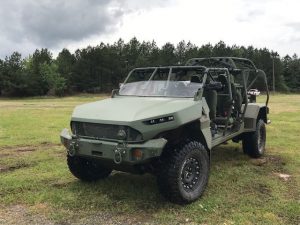The Army’s Rapid Capabilities and Critical Technologies Office (RCCTO) recently received approval to pursue a program aimed at integrating a 20-kilowatt laser capability on Infantry Squad Vehicles (ISV), according to a lead official.
Lt. Gen. Neil Thurgood, director of the RCCTO, said Wednesday the goal for the new Army Multi-Purpose High Energy Laser (AMP-HEL) program is to deliver a counter-drone laser capability to help protect Infantry Brigade Combat Teams.

“We got that mission approved a week ago or so and we have to deliver that in FY ‘23,” Thurgood told attendees at the Space and Missile Defense Symposium in Huntsville, Alabama.
The ISV-mounted 20kw laser for AMP-HEL would specifically be focused on the ability to take out Group 1 and 2-sized drones, according to Thurgood.
“With a 20 kilowatt [laser], we can kill Group 1 and Group 2 [UAS]. Generally, you can’t kill Group 3 [UAS]. Generally, you can’t kill rockets, artillery and mortar. You don’t have enough time. The mortar round hits you before you can kill it. You might get some of them. But it’s focused on the counter-UAS mission,” Thurgood said.
GM Defense [GM] manufactures the Army’s new lightweight air-droppable ISV, based on the ZR2 variants of the Chevrolet Colorado midsize truck.
The Army recently achieved its First Unit Equipped milestone for the ISV, after delivering an initial group of 59 vehicles to an element of the 82nd Airborne Division.
Thurgood also noted the Army is readying for delivery of its first Stryker-mounted 50-kilowatt lasers in “about 45 days,” which will go to a unit at Fort Sill in Oklahoma.
That program, called Directed Energy Maneuver-Short Range Air Defense (DE M-SHORAD), aims to field an on-the-move laser system capable of taking down unmanned aerial systems, rotary-wing aircraft and rockets, artillery and mortars, with the Army having now conducted two live fire events with the prototype capability.
“One was at Ft. Sill where we killed a lot of Group 1, 2 and 3 UASs and tracked a lot of mortar rounds. I was wholly unsatisfied with that outcome. So I sent them back to White Sands [Missile Range in New Mexico] six months later to start doing the same thing and kill mortar rounds,” Thurgood said.
The Army’s DE M-SHORAD prototyping effort involves Raytheon Intelligence and Space [RTX] as the lead laser module integrator, with Kord Technologies providing the 50-kilowatt laser system.
Last November, the Army announced plans to award Kord Technologies another prototype deal to deliver eight additional DE M-SHORAD prototypes, with four to be delivered in fiscal year 2023 and four more in FY ‘24 (Defense Daily, Nov. 19).